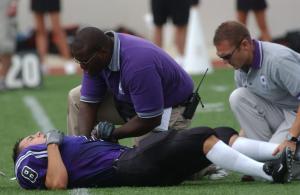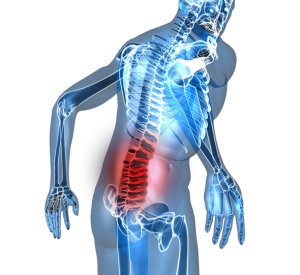Research Team Members: Kristen L. Kucera, Karen G. Roos, Jennifer M. Hootman, Hester J. Lipscomb, John M. Dement, Barbara Silverstein
 Why did you do this study?
Why did you do this study?
Athletic trainers (AT) provide for the health, wellbeing, treatment, and rehabilitation of patients in a variety of employment settings, including colleges and universities, secondary schools, professional athletic organizations, hospitals, medical and physical therapy clinics, and work-site health clinics. ATs perform similar clinical tasks as physical therapists and nurses and have similar physical exposures during emergency management and treatment as emergency medical technicians. Though overlap exists in some work tasks with these professions, no one job category encompasses the work exposures for ATs. Work settings for ATs have traditionally included collegiate and secondary schools, professional and amateur sports. The past 20 years have brought about a shift and ATs are now found in a variety of work settings including hospitals, medical, physical therapy, or industry work-site clinics, fitness centers and military and government centers.
The bulk of previous research on the occupational health of ATs has been limited to predictors of stress, burnout, and physical activity level. Studies have often been small-scale, cross sectional surveys limited to particular regions of the country, occupational settings (universities or high schools) or collegiate Divisions. No research to date has examined injuries or illnesses reported to state-based or insurance-based workers compensation among this population. Improving the understanding of work-related injuries and illnesses among ATs will be important for maintaining a healthy occupational work force. The purpose of this study was to determine the incidence and describe the characteristics of work-related injuries and illnesses experienced by ATs and reported to two states’ workers compensation programs over an 11-year period.
What did you do and what did you find in this study?
Workers’ compensation claims filed by injured or ill ATs in Washington and California were identified by linking the claims from 2001-2011 with a list of all certified athletic trainers provided by the Board of Certification, Inc. Linked datasets were de-identified and provided for review and analysis. We reviewed all claims to ensure they were related to athletic training work.
 Over 80% of the workers’ compensation claims were traumatic injuries and disorders. Injuries to the back, fingers, and knees were most frequent. Half of injuries were sprains and strains from body motion (or reaction) or due to overexertion (e.g., lifting patients, lifting ice chests). A quarter of injuries were due to contact with objects or equipment (balls, bats, etc.) or other persons (players or patients). Higher reported injury claim rates were observed for females compared to males, and in clinic and hospital settings compared to school settings. In clinic and hospital or other work settings, injuries were more often due to patient care-related tasks whereas injuries due to athletic event and prep-related tasks were more frequent in school and athletic settings.
Over 80% of the workers’ compensation claims were traumatic injuries and disorders. Injuries to the back, fingers, and knees were most frequent. Half of injuries were sprains and strains from body motion (or reaction) or due to overexertion (e.g., lifting patients, lifting ice chests). A quarter of injuries were due to contact with objects or equipment (balls, bats, etc.) or other persons (players or patients). Higher reported injury claim rates were observed for females compared to males, and in clinic and hospital settings compared to school settings. In clinic and hospital or other work settings, injuries were more often due to patient care-related tasks whereas injuries due to athletic event and prep-related tasks were more frequent in school and athletic settings.
How do these findings impact the public?
These results are important for identifying risk factors for work-related injuries among a fast growing occupational group. Given the variety of work settings that employ athletic trainers, these findings suggest that prevention efforts need to begin pre-certification and address the settings an AT might find themselves working in. Intervention strategies developed for other health care professions such as minimal manual lift training may be useful for ATs. The types of injury events unique to school and athletic settings, such as being unintentionally struck by athletic equipment or an athlete and exertional injuries due to handling heavy equipment including coolers of ice and water, support the need for intervention strategies targeted to these settings.
Paper currently in press at the American Journal of Industrial Medicine
